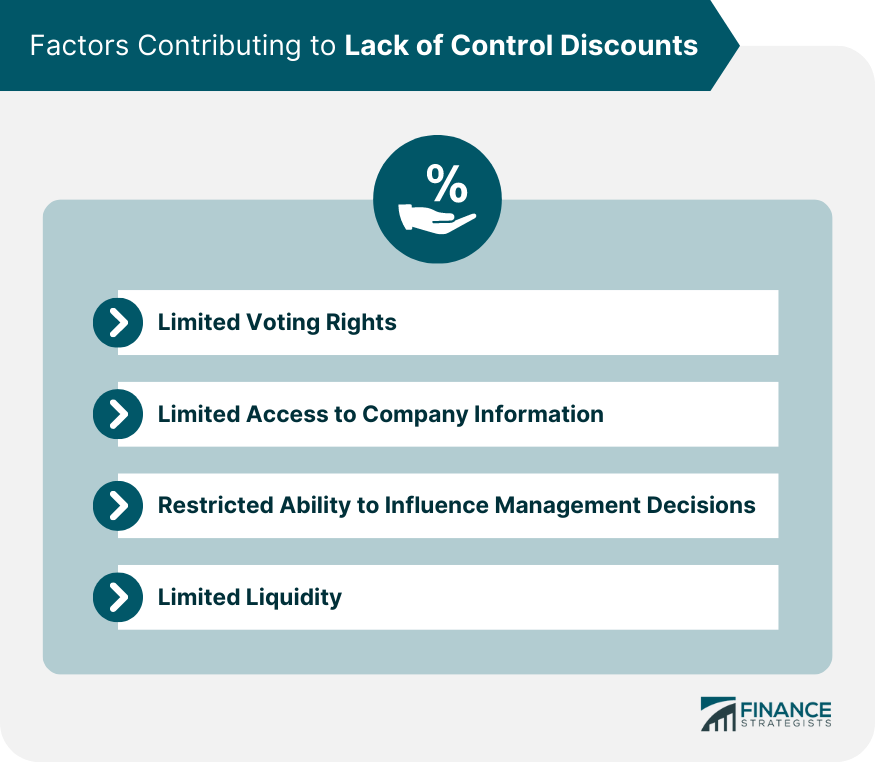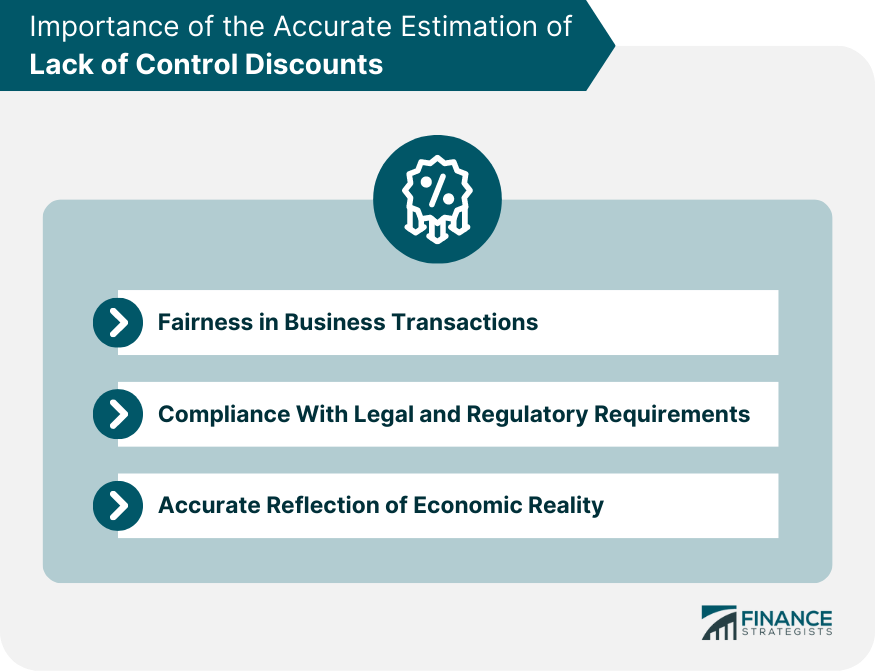Lack of control discounts, also known as minority interest discounts, refer to the reduction in the value of an ownership interest in a business due to the owner's inability to exercise control over the company's operations and decision-making. This discount typically applies to minority shareholders who hold less than 50% of the company's shares or voting rights. The purpose of applying a lack of control discount is to accurately reflect the value of a minority ownership interest in a business. It is commonly used in business valuations for purposes such as mergers and acquisitions, shareholder disputes, estate planning, and tax reporting. Minority shareholders generally have limited voting rights, which restrict their ability to influence the company's strategic decisions, such as mergers, acquisitions, or changes in management. Minority shareholders may have limited access to the company's financial and operational information, which can hinder their ability to assess the company's performance and make informed investment decisions. Due to their limited ownership stake, minority shareholders may have little or no influence over management decisions, such as the appointment of directors, executive compensation, or the declaration of dividends. Minority interests in privately-held companies may have limited liquidity, as there may not be an active market for these shares. This lack of liquidity can make it difficult for minority shareholders to sell their ownership interests at a fair market value. The guideline public company method is a market-based approach that compares the subject company to publicly traded companies in the same industry. This method takes into account the lack of control discount by adjusting the valuation multiples derived from the public company comparables. The precedent transaction method is another market-based approach that compares the subject company to similar companies involved in past transactions. This method considers the lack of control discount by adjusting the transaction multiples based on the level of control associated with each transaction. The market approach is a broader valuation method that incorporates both the guideline public company and precedent transaction methods. This approach adjusts valuation multiples for the lack of control discount, considering the factors that contribute to the discount in each case. The income approach, which includes methods such as discounted cash flow (DCF) and capitalized earnings, can also incorporate a lack of control discount. This is achieved by adjusting the discount rate or capitalization rate to reflect the minority shareholder's limited control. One way to estimate the lack of control discount is by analyzing comparable transactions involving minority interests. The difference in valuation multiples between controlling and non-controlling transactions can provide an indication of the appropriate discount. Market data, such as studies and surveys on minority interest discounts in specific industries, can also be useful in estimating the lack of control discount. This information can help determine the typical range of discounts applied in similar situations. Examining industry norms and practices can provide insights into the typical lack of control discounts applied in a particular industry. This can help ensure that the applied discount is consistent with market expectations and reflects the economic reality of the minority interest. Applying a lack of control discount reduces the value of a minority ownership interest in a business, reflecting the limited control and influence associated with such interests. The application of a lack of control discount can affect negotiation dynamics in transactions involving minority interests, as it can influence the bargaining power of minority shareholders and potential acquirers. Lack of control discounts can have significant implications for taxation and estate planning purposes, as the discounted value of a minority interest may result in lower tax liabilities or estate valuations. Accurate estimation of the lack of control discount is essential to ensure fairness in business transactions involving minority interests, as it helps to ensure that the value assigned to these interests accurately reflects their limited control and influence. Proper estimation and application of the lack of control discount can help businesses and individuals comply with legal and regulatory requirements related to business valuations, such as tax reporting and estate planning regulations. Applying an appropriate lack of control discount helps to provide a more accurate reflection of the economic reality of a minority interest in a business, taking into account the various factors that contribute to the discount. The concept of lack of control discount plays a crucial role in business valuation, as it helps to accurately reflect the value of minority ownership interests. By considering the various factors that contribute to the discount, such as limited voting rights, limited access to company information, and restricted ability to influence management decisions, valuations can provide a more accurate representation of the economic reality of a minority interest. The proper estimation and application of the lack of control discount are essential for ensuring fairness in business transactions, compliance with legal and regulatory requirements, and accurate reflection of economic reality. By carefully considering the factors contributing to the discount and using appropriate valuation methods, businesses and individuals can achieve more accurate and reliable valuations for minority interests.What Is a Lack of Control Discount?
Factors Contributing to Lack of Control Discounts
Limited Voting Rights
Limited Access to Company Information
Restricted Ability to Influence Management Decisions
Limited Liquidity

Valuation Methods Incorporating Lack of Control Discounts
Guideline Public Company Method
Precedent Transaction Method
Market Approach
Income Approach
Estimating Lack of Control Discounts
Analyzing Comparable Transactions
Reviewing Market Data
Assessing Industry Norms
Impact of Lack of Control Discounts on Valuation
Reducing the Value of Minority Interests
Affecting Negotiation Dynamics
Implications for Taxation and Estate Planning
Importance of the Accurate Estimation of Lack of Control Discounts
Fairness in Business Transactions
Compliance With Legal and Regulatory Requirements
Accurate Reflection of Economic Reality

Conclusion
Lack of Control Discount FAQs
A lack of control discount is a reduction in the value of a minority interest in a company due to the lack of control that the holder of that interest has over the company's operations and decision-making.
A lack of control discount is applied because minority shareholders are typically unable to make decisions that could significantly impact the direction of the company, as they lack the voting power to do so. This reduction in control makes minority interests less attractive to investors and, therefore, less valuable.
The lack of control discount is calculated by comparing the value of a controlling interest in the company with the value of a minority interest in the same company. The difference between the two values represents the discount applied to the minority interest.
The size of a lack of control discount can vary depending on a variety of factors, including the company's size and complexity, the nature of its operations, and the level of shareholder activism within the company. Additionally, the size of the discount may be affected by the specific terms of the minority interest being valued, such as any restrictions on the transferability of the interest.
One way to mitigate the impact of a lack of control discount is to structure the minority interest in a way that provides some level of control or influence over the company's operations. This could include provisions for increased voting power or representation on the board of directors. Additionally, obtaining a formal valuation from a qualified appraiser can help to ensure that the impact of the lack of control discount is accurately reflected in the value of the minority interest.
True Tamplin is a published author, public speaker, CEO of UpDigital, and founder of Finance Strategists.
True is a Certified Educator in Personal Finance (CEPF®), author of The Handy Financial Ratios Guide, a member of the Society for Advancing Business Editing and Writing, contributes to his financial education site, Finance Strategists, and has spoken to various financial communities such as the CFA Institute, as well as university students like his Alma mater, Biola University, where he received a bachelor of science in business and data analytics.
To learn more about True, visit his personal website or view his author profiles on Amazon, Nasdaq and Forbes.











